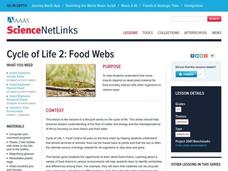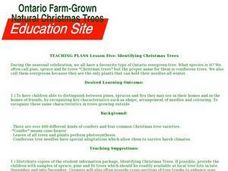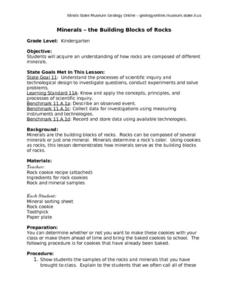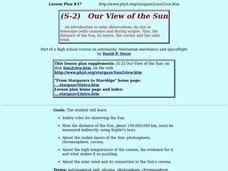Curated OER
Exploring Rocks
Students recognize differences in the size, shape, texture, and color of different rocks. For this rocks lesson plan, students also learn and repeat back how a volcano erupts and make one out of a toilet paper tube.
Curated OER
Organic Matter in Soils
Students recognize the presence of organic matter in soils from their immediate area and recognize which soil sample contains the highest concentration of organic matter.
Curated OER
Insects: Grasshoppers
Students examine grasshoppers as they practice following instructions. In this biology lesson plan, students identify the characteristics of grasshoppers and the functions of grasshoppers' external body parts.
Curated OER
The"Dirt" on Soil
Students examine the three different types of soil and their physical properties. In this soil activity students design and implement a model of a water treatment plant.
Curated OER
Where Are the Dinosaurs?
Students examine the concept of extinction by studying dinosaurs. In this living environment activity, students view dinosaur video clips and define the word "extinction." Students visit the "Zoom Dinosaur" website to investigate various...
Curated OER
Rocks and Minerals
Learners identify how weathering and erosion effect the Earth's surface. In this weathering and rocks lesson, students study various types of rocks in water and brainstorm ways the Earth's surface changes. Learners view an interactive...
Curated OER
Which Is My Peanut?
Young scholars observe peanuts. In this observation lesson, students get a peanut and write down the distinguishable characteristics. They weigh and measure their peanut, then try to identify it when it is put in a group with the rest of...
Curated OER
Salty Sea Water
Students conduct an experiment to find out if there is salt in the ocean. In this scientific inquiry instructional activity, students pour a cup of salt water onto an aluminum plate and observe the changes over a few days. Students...
Curated OER
Water Quality Survey
Students identify the differences in the water quality of a stream and complete water testing. In this water quality activity students collect aquatic insects and identify them.
Curated OER
From Flower to Fruit
Students examine how flowers have essentially four parts. They learn both the male and female reproductive parts of the flower, then explore self-pollination and pollination by insects and other animals.
Curated OER
Lesson Five: Identifying Christmas Trees
Stuudents distinguish between pines, spruces and firs they may see in their homes, by recognizing key characteristics such as shape, arrangement of needles and colouring. They recognize these same characteristics in trees growing outside.
Curated OER
Jewel of the Earth
Students investigate several organisms, set sticky traps to collect them, and attempt to identify and classify them using a variety of sources. The origins of the organisms are traced and their adaptive features examined.
Curated OER
Guess What?! (a lesson about atoms)
Pupils investigate atoms as particles that make up all matter. They examine the mass of matter.
Curated OER
The Lorax
Students read The Lorax and discuss how human actions can affect the environment. They conduct a simple experiment to see how much air pollution is in the air that they breathe.
Curated OER
Naturalist's Notebook
Students observe and record the behavior of a San Diego wetland animal and the characteristics of its environment. The amount of time that each animal spends resting, grooming, eating, flying, and social or individual play becomes the...
Curated OER
Minerals- the Building Blocks of Rocks
Pupils investigate how rocks are composed minerals by dissecting rock cookies.
Curated OER
Our View of the Sun
Students are introduced to safety rules for observing the Sun, how the distance of the Sun is measured using Kepler's Laws and identify the visible layers of the Sun. They discuss solar eclipses and view images of eclipses using the...
Curated OER
Particle Depostition Lab
Learners collect, study and observe the pollution in our air. They list three kinds of pollution that they think is in our air. Students comprehend that the atmosphere is almost completely made up of invisible gaseous substances. They...
Curated OER
Introduction To Insect & Spider Body Parts
Students inspect several different specimens of insects and spiders to determine characteristics that are similar and different between the two groups. They identify the basic body structure of spiders and insects and then predict where...
Curated OER
Peanut Processes
Students use the senses are to make observations about phenomena. They use a peanut and its shell as the object of a series of observations. In addition, they complete a drawing with their written observations to use as a guide to choose...
Curated OER
Condensation and the Water Cycle
Students explore the natural distallation process that occurs in the water cycle. They use plastic cups and cotton swabs to observe the condensation process that is evident in the water cycle.
Curated OER
Hatching Brine Shrimp
Learners experiment with temperature and salinity to detect favorable environments for hatching brine shrimp eggs. They make some predictions about which environments will yield the most hatched brine shrimp and record the number of...
Curated OER
Barn Owl Pellet Lab
In this lab worksheet, students dissect a barn owl pellet then identify the different small animals found in the owl pellet. Using class data they calculate percentage present as well as complete 8 post lab questions.
Curated OER
Looking for Minibeasts
In this minibeasts worksheet, students participate in a "minibeasts safari" where they collect a variety of different types of bugs in a jar, examine them and then return them to their original inhabitants.























